9.1 迭代器

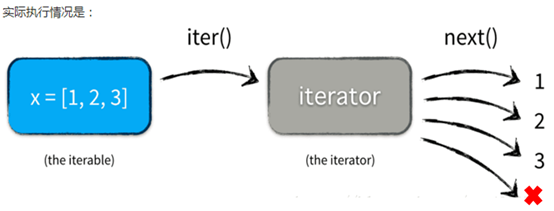
创建迭代器的3种方法:
方法一:
容器对象添加 __iter__() 和 __next__() 方法(Python 2.7 中是 next());__iter__() 返回迭代器对象本身 self,__next__() 则返回每次调用 next() 或迭代时的元素;
自定义一个迭代器:
1. class Contain: 2. def __init__(self,start,end): 3. self.start = start #self.start既是开始位置,也是记录位置的状态 4. self.end = end 5. def __iter__(self): 6. print('调用iter方法!') 7. return self #/__iter()__返回自身self 8. def __next__(self): 9. if self.start < self.end: 10. i = self.start 11. self.start += 1 12. return i 13. else: 14. raise StopIteration 15. Con = Contain(0,5) 16. for i in Con: 17. print(i)
方法二:
使用内建函数iter()可以从可迭代对象中获得迭代器。示例:
1. li = [2,5,3,7,9,10] 2. it = iter(li) 3. print(next(it), end=' ') #2 4. print(next(it), end=' ') #5以此类推
方法三:
利用生成器(generator),生成器通过yield语句快速生成迭代器,省略了复杂的__iter()__和__next()__方式
参考原文:https://blog.csdn.net/qq_42068900/article/details/80369029
9.2 生成器

创建生成器:
1:generator 第一种创建方式(推导式):
输入:
1. nums = (x for x in range(10)) 2. print(nums) #<generator object <genexpr> at 0x0000004590AB9938> 生成器类型 3. for i in nums: 4. print(i, end=' ') #0 1 2 3 4 5 6 7 8 9
输出:
runfile('C:/Users/lf/Desktop/Python/Python练习/迭代器和生成器.py', wdir='C:/Users/lf/Desktop/Python/Python练习')
<generator object <genexpr> at 0x000002899B831360>
0 1 2 3 4 5 6 7 8 9
2:第二种创建方式(斐波那契数列):
输入:
1. fibs = [] 2. def Fib(): 3. for i in range(100): 4. if i > 1: 5. fibs.append(fibs[i-2]+fibs[i-1]) 6. else: 7. fibs.append(1) 8. yield fibs[i] #print换成yield ,每次生成一个值 9. fibnaqi = Fib() 10. print(fibnaqi.__next__()) #1 11. print(next(fibnaqi)) #1 12. print(next(fibnaqi)) #2 13. print(next(fibnaqi)) #3 14. print(next(fibnaqi)) #5 15. print(next(fibnaqi)) #8 16. print(next(fibnaqi)) #13
输出:
runfile('C:/Users/lf/Desktop/Python/Python练习/迭代器和生成器.py', wdir='C:/Users/lf/Desktop/Python/Python练习')
1 1 2 3 5 8 13
9.3 打开文件


标准函数是:
open(filename,mode=’r’,buffering=-1,encoding=None, errors=None, newline=None, closefd=True, opener=None)

常见问题:
Python中遇到"UnicodeDecodeError: ‘gbk’ codec can’t decode bytes in position 2-3: illegal multibyte sequence"之类的编码或解码的错误时如何处理。
如何解决,参考原文:https://www.crifan.com/summary_python_unicodedecode_error_possible_reasons_and_solutions/
9.4 读取文件

1:readlines()

2:readline()
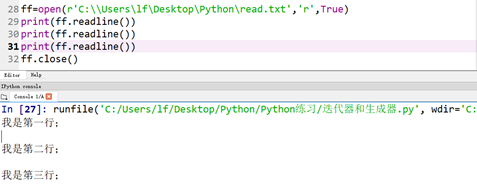
3:read()
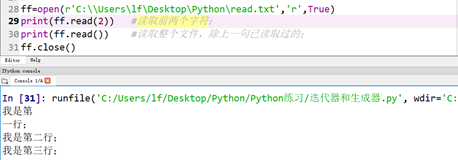
4:tell()

5:truncate()

6:seek()

9.5 写入文件
1:write() 将字符串写入文件

2:writelines() 写入多行数据

9.6 关闭和刷新文件
1:close() 关闭文件函数
2:flush() 刷新文件

12.1 图像的处理
1、下载和安装Pillow
方法一:

方法二:

2、加载图像文件
示例一:
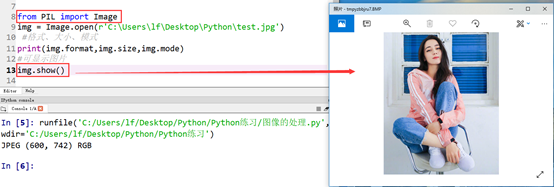
示例二:
from tkinter import * from PIL import Image, ImageTk #创建主窗口 win = Tk() win.title(string="加载图像文件") imgFile1 = Image.open(r'C:UserslfDesktopPython�1.bmp') imgFile2 = Image.open(r'C:UserslfDesktopPython�2.jpg') imgFile3 = Image.open(r'C:UserslfDesktopPython�3.tif') imgFile4 = Image.open(r'C:UserslfDesktopPython�4.gif') img1 = ImageTk.PhotoImage(imgFile1) img2 = ImageTk.PhotoImage(imgFile2) img3 = ImageTk.PhotoImage(imgFile3) img4 = ImageTk.PhotoImage(imgFile4) canvas = Canvas(win, width=850,height=500) canvas.create_image(0, 0, image=img1, anchor=NW) canvas.create_image(450, 0, image=img2, anchor=NW) canvas.create_image(0, 250, image=img3, anchor=NW) canvas.create_image(450, 250, image=img4, anchor=NW) canvas.pack(fill = BOTH) #开始程序循环 win.mainloop()

3、复制与粘贴图像
image模块的copy()方法,来复制该图像,copy();
image模块的paste()方法,来粘贴该图像,paste(image, box);
image模块的crop()方法,剪切该图像中的一个矩形方块,crop(box)。
示例:
from tkinter import * from PIL import Image, ImageTk #创建主窗口 win = Tk() win.title(string="复制与粘贴图像") #打开图像文件 imgFile = Image.open(r'C:UserslfDesktopPython est02.jpg') #创建第一个图像实例变量 img1 = ImageTk.PhotoImage(imgFile) #读取图像文件的宽和高 width, height = imgFile.size #设置剪切下的区块范围 box1 = (0, 0, width, int(height/2)) #将图像的上半部分剪切下来 part = imgFile.crop(box1) #将剪切下的部分旋转 part = part.transpose(Image.ROTATE_180) #将剪切下,处理后的部分,粘贴 imgFile.paste(part, box1) #创建第二个图像实例变量 img2 = ImageTk.PhotoImage(imgFile) #创建Label控件,来显示图像 label1 = Label(win, width=400, height=400, image=img1, borderwidth=1) label2 = Label(win, width=400, height=400, image=img2, borderwidth=1) label1.pack(side= LEFT) label2.pack(side= LEFT) #开始循环程序 win.mainloop()
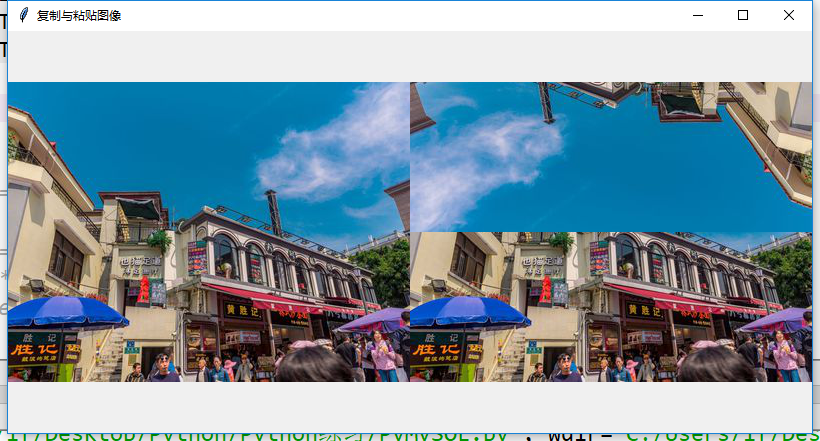
4、图像的几何转换
(1)改变图像的大小:使用resize()方法,语法格式为resize((width, height));
(2)旋转图像:使用rotate()方法,语法格式为rotate(angle);
(3)颠倒图像:使用transpose()方法,语法格式为transpose(method)。
示例:
from tkinter import * from PIL import Image, ImageTk #创建主窗口 win = Tk() win.title(string="图像的几何转换") #打开图像文件 imgFile1 = Image.open(r'C:UserslfDesktopPython est1.jpg') #创建第一个图像实例变量 img1 = ImageTk.PhotoImage(imgFile1) #创建Label1控件,来显示原始图像 label1 = Label(win, width=300, height=400, image=img1) label1.pack(side = LEFT) #旋转图像成45°角 imgFile2 = imgFile1.rotate(45) img2 = ImageTk.PhotoImage(imgFile2) #创建Label2控件,来显示图像 label2 = Label(win, width=300, height=400, image=img2) label2.pack(side = LEFT) #旋转图像成90°角 imgFile3 = imgFile1.transpose(Image.ROTATE_90) img3 = ImageTk.PhotoImage(imgFile3) #创建Label3控件,来显示图像 label3 = Label(win, width=300, height=400, image=img3) label3.pack(side = LEFT) #改变图像为四分之一大小 width, height = imgFile1.size imgFile4 = imgFile1.resize((int(width/2),int(height/2))) img4 = ImageTk.PhotoImage(imgFile4) #创建Label3控件,来显示图像 label4 = Label(win, width=300, height=400, image=img4) label4.pack(side = LEFT) #开始循环程序 win.mainloop()

13.3 操作MYSQL数据库
Python中操作MySQL的模块是PyMySQL,在导入MySQL数据之前,需要安装PyMySQL模块。目前Python3.x仅支持PyMySQL,不支持MySQLdb。安装PyMySQL,如下:

1、连接数据库
代码:
import pymysql #打开数据库连接 db = pymysql.connect('localhost','lifeng','123456','shopping') #使用cursor()方法,创建一个游标对象cursor cursor = db.cursor() #使用execute()方法执行SQL查询 cursor.execute("SELECT VERSION()") #使用fetchone()方法获取单条数据 data = cursor.fetchone() #打印数据库版本号 print("Database version:%s" % data) #关闭数据库 db.close()
2、在数据库创建表
代码:
import pymysql #打开数据库连接 db = pymysql.connect('localhost','lifeng','123456','pymysql') #使用cursor()方法,创建一个游标对象cursor cursor = db.cursor() #定义SQL语句 sql = """CREATE TABLE student4(id INT(10) NOT NULL UNIQUE, name CHAR(20) NOT NULL, age INT, sex CHAR(1))""" #使用execute()方法执行SQL查询 cursor.execute(sql) #关闭数据库 db.close()
3、在数据库插入数据
代码:
import pymysql import sys #打开数据库连接 db = pymysql.connect('localhost','lifeng','123456','pymysql') #使用cursor()方法,创建一个游标对象cursor cursor = db.cursor() #定义SQL语句 sql = "INSERT INTO student (id, name, age, sex) VALUES ('%d', '%s', '%d', '%s')" % (4 , '迪丽热巴', 25, 'F') try: #执行插入数据语句 cursor.execute(sql) #提交到数据库执行 db.commit() except: #如果发生错误,则回滚到插入操作之前 info = sys.exc_info() exc_type = info[0] exc_value = info[1] exc_traceback = info[2] print (exc_type, ":", exc_value) db.rollback() #回滚函数,回到错误操作之前,防止错误数据被插入。 #关闭数据库 db.close()
插入后的结果:

4、查询数据库
代码:
import pymysql #打开数据库连接 db = pymysql.connect('localhost','lifeng','123456','pymysql') #使用cursor()方法,创建一个游标对象cursor cursor = db.cursor() #定义SQL语句 sql = "SELECT * FROM student WHERE age > '%d'" % (23) try: #执行插入数据语句 cursor.execute(sql) results = cursor.fetchall() for row in results: id = row[0] name = row[1] age = row[2] sex = row[3] #打印查询结果 print ("id=%d, name=%s, age=%d, sex=%s " % (id, name, age, sex)) except: #如果发生错误,则回滚到插入操作之前 print("错误:无法查询到数据!!!") #关闭数据库 db.close()
查询结果:

5、修改数据库数据
代码:
import pymysql #打开数据库连接 db = pymysql.connect('localhost','lifeng','123456','pymysql') #使用cursor()方法,创建一个游标对象cursor cursor = db.cursor() #定义SQL语句 sql = "UPDATE student SET age=age -1" try: #执行插入数据语句 cursor.execute(sql) #提交到数据库执行 db.commit() except: db.rollback() #回滚函数,回到错误操作之前,防止错误数据被插入。 #关闭数据库 db.close()
修改结果:

6、删除数据库数据
代码:
import pymysql import sys #打开数据库连接 db = pymysql.connect('localhost','lifeng','123456','pymysql') #使用cursor()方法,创建一个游标对象cursor cursor = db.cursor() #定义SQL语句 sql = "DELETE FROM student WHERE sex = '%s'" % ('F') try: #执行插入数据语句 cursor.execute(sql) #提交到数据库执行 db.commit() except: #如果发生错误,则回滚到插入操作之前 info = sys.exc_info() exc_type = info[0] exc_value = info[1] exc_traceback = info[2] print (exc_type, ":", exc_value) db.rollback() #回滚函数,回到错误操作之前,防止错误数据被插入。 #关闭数据库 db.close()
删除后结果:

7、遇到的问题
期间遇到一个问题:<class 'pymysql.err.OperationalError'> : (1142, "DELETE command denied to user 'lifeng'@'localhost' for table 'student'");
是因为“lifeng”这个数据库没有DELETE权限,需要设置权限,参考:https://blog.csdn.net/u014183172/article/details/78509017
——————————————————————————————————————————————————————————————————
初步了解numpy、pandas等内容,以及数据处理部分内容。下周准备学习数据处理、数据分析两章内容,进行简单的数据分析。